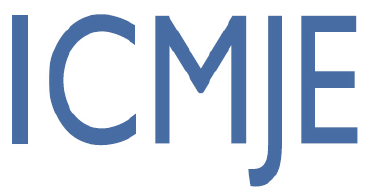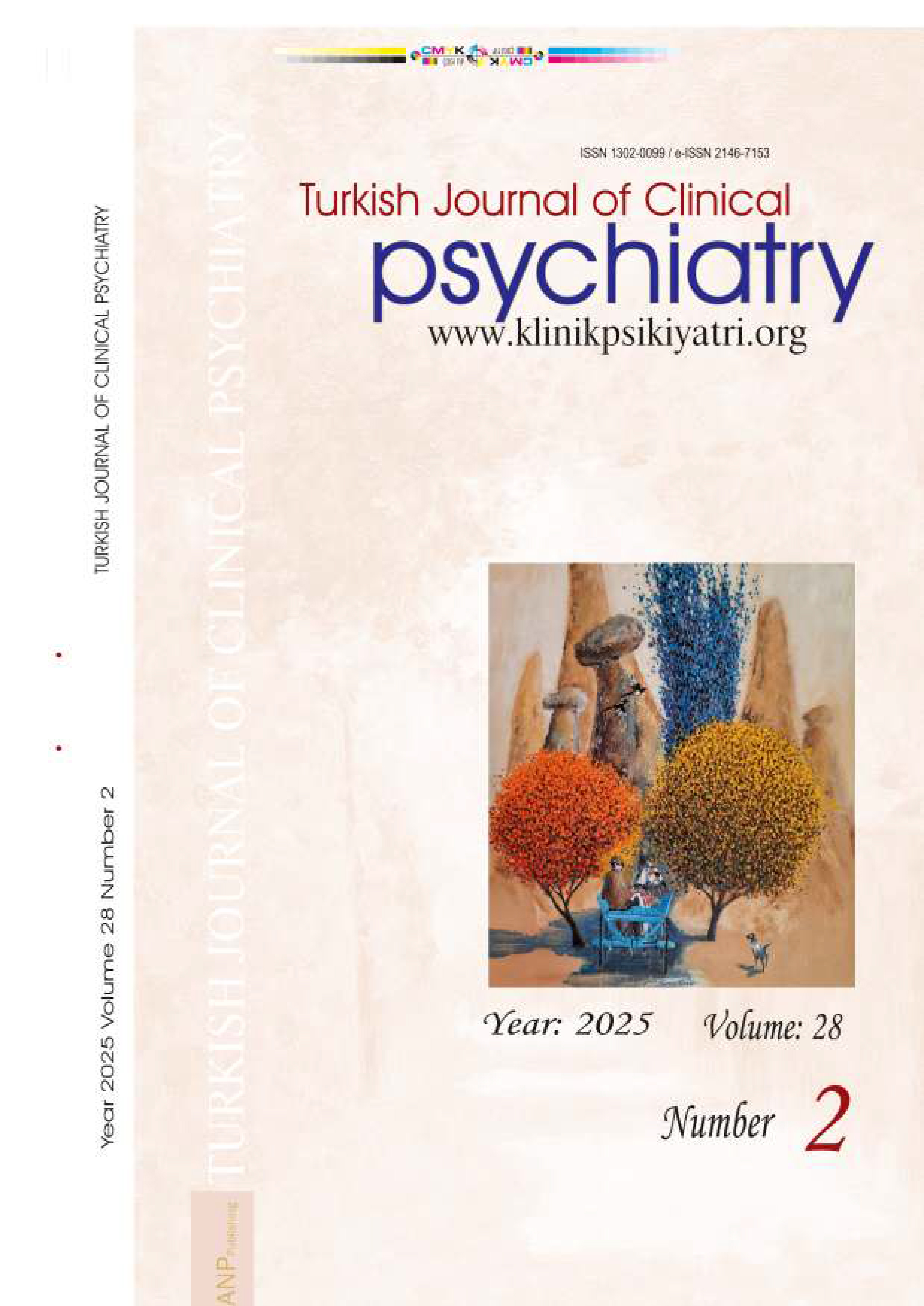





Volume: 21 Issue: 1 - 2018
| EDITORIAL | |
| 1. | Truth heals as much as it hurts Burhanettin Kaya Pages 5 - 6 Abstract | |
| RESEARCH ARTICLE | |
| 2. | Psychiatric Disorders, Sociodemographic Features and Risk Factors in Children Driving to Committing Crime (Turkish) Murat Eyüboğlu, Damla Eyüboğlu doi: 10.5505/kpd.2018.02997 Pages 7 - 14 INTRODUCTION: The aim of this study was to examine children driving to committing crime who were brought to psychiatry clinic for forensic evaluation because of the crimes they committed to. Additionally, evaluation of these children's psychiaytric disorders, crime characteristics, sociodemographic data, factors driving to committing crime and forensic reports arranged by the physician were other aims. METHODS: In this study 204 children, who were brought to the clinic in order to be evaluated whether they perceive the legal meaning and consequences of that action or possess sufficient ability to channel their behaviors, were included. In order to diagnose any psychiatric disorder, a structured interrogation schedule for affective disorders and schizophrenia for present and lifetime was applied all children and families and sociodemographic data form was completed. RESULTS: At least one psychiatric disorder was present in 47% (n =96) of children driving to committing crime. The most common disorders were Attention Deficit and Hyperactivity Disorder and Conduct Disorder. Almost none of them have been treated before. 45% of them dropped out their school, and 40% were smoking. Additionally, most of their parents who had low socio-economical level also had very low education level. DISCUSSION AND CONCLUSION: It was determined that being male, living in a low socioeconomic family environment, living in large families, using drugs, smoking, not attending school and having parents with low education level were significant related factors for juvenile delinquency. |
| 3. | Socio-demographic and Clinical Features of Young Adult Males Using Synthetic Cannabinoid (English) Taner Öznur, Havva Öznur, Abdullah Bolu, Cemil Çelik, Kamil Nahit Özmenler doi: 10.5505/kpd.2018.07269 Pages 15 - 23 INTRODUCTION: Synthetic Cannabinoid (SC) use is becoming more widespread throughout the world. Studies that revealed user profiles indicate that the drug is especially popular among young men. Knowledge on socio-demographic, clinical characteristics and motivation for SC users in our country is limited. On the other hand, in spite of the increase of information known about symptoms of acute intoxication of SC use, physical and psychiatric consequences and loss of function due to long-term use of SC is limited. In this study, we aimed to investigate socio-demographic and clinical characteristics associated with SC use and the negative consequences caused by the use of SC. METHODS: 166 male patients who admitted to the psychiatric outpatient clinic due to SC use disorder between November 2014 to April 2015 were enrolled in the study. Demographic data of patients, substance use characteristics, familial substance use, reasons for substance use, medical history, the problems related to drug use was questioned. RESULTS: The age of onset for SC use was found to be 17.25 ± 2.30. SC using duration was 3.79 ± 2.15 years. The most common agents accompanying SC use were smoking (95.8%) and cannabis (88.6%). It was determined that 62.7% developed suicidal ideas due to SC use. Among psychiatric side effects, most common were euphoria, hallucinations, skepticism and suicidal ideation. About 1/3 of cases were found to live loss of business and legal issues depending on long-term SC use. 76.5% of the patients' consumed SC through inhalation and 22.9 % orally. It was determined that oral users began SC use at an earlier age than users via inhalation. DISCUSSION AND CONCLUSION: Despite the physical, mental, occupational, social and legal problems caused by the use of SC, it has become an important public health problem, especially among young men. Effective intervention programs for the use of outbreaking SCs need to be developed. |
| 4. | Re-examining psychometric properties of the Turkish form of the Guilt Inventory in a non-clinical and depression sample (Turkish) Burçin Akın, Bikem Hacıömeroğlu, Müjgan İnözü doi: 10.5505/kpd.2017.52523 Pages 24 - 37 INTRODUCTION: In the most general sense, guilt is conceptualized as a strong, intense and negative emotion that quickly emerges when people do not live up according to internal values, judgements and social standards or violate them. The aim of the present study was to investigate the factor structure of Guilt Inventory that developed by Kugler and Jones with confirmatory and explanatory factor analyses and reevaluate the psychometric properties of the new Turkish form in depression and non-clinical samples. METHODS: For this purpose, 448 university students, 107 healthy controls and 56 adults diagnosed with depression were asked to fill out the questionnaire set consisted of the Guilt Inventory, Beck Depression Inventory, Disgust Scale- Revised Form and The State-Trait Anxiety Inventory-State Anxiety Form. RESULTS: According to the results, original form of Guilt Inventory did not work at the desired level in Turkish culture. Confirmatory and exploratory factor analyzes revealed that the new form with 35 items and 3 subscales works much more appropriately. The analyses of group comparison and correlations with other scales indicated that Turkish version of the Guilt Inventory had satisfactory convergent, divergent and criterion validity. Additively, internal consistency, item-total correlations and Guttman split-half reliability coefficients showed that the Turkish form of Guilt Inventory had good reliability values which were comparable to the original version of the scale. DISCUSSION AND CONCLUSION: In conclusion, results revealed that the Turkish version of Guilt Inventory is a reliable and valid measurement tool. |
| 5. | The Mediating Role Of Coping Styles In Personal, Environmental and Event Related Factors and Posttraumatic Growth Relationships Among Women With Breast Cancer (English) Zümrüt Bellur, Arzu Aydın, Emre Han Alpay doi: 10.5505/kpd.2018.65365 Pages 38 - 51 INTRODUCTION: The aim of this study was to examine the effects of environmental, personal and event related factors on posttraumatic growth in breast cancer patients. METHODS: The study was conducted with 134 women who are undergoing chemotherapy treatment or coming to the hospital for their routine controls. Revised Dyadic Adjustment Scale, The Impact of Event Scale, Posttraumatic Growth Inventory, Ways of Coping Inventory, Multidimensional Scale of Perceived Social Support, The General Self-Efficacy Scale-Turkish Form and Demographic Information Form was used. RESULTS: Acoording to t-test analyses as the time passage from the diagnosis increases the perceived social support from the family members is increasing. Also while the group that had previous trauma experiences uses more helplessness coping styles, the group that had no previous trauma experience uses more problem focused coping style and showed greater posttraumatic growth. Results of the mediation analyses showed that problem focused coping has a mediator role in dyadic adjustment- posttraumatic growth; perceived social support from the family- posttraumatic growth; and self-efficacy- posttraumatic growth relationships DISCUSSION AND CONCLUSION: The results of the current study are important in terms of developing new intervention programs that will help breast cancer patients to develop posttraumatic growth and also to better cope with cancer. This study is also important because the effect of marital adjustment and marital satisfaction on posttraumatic growth in breast cancer patients is an issue which is not well studied with Turkish sample. |
| 6. | Psychometric Properties of the Turkish version of Looming Maladaptive Style Questionnaire (LMSQ) (Turkish) Ayşe Altan Atalay, Dilek Sarıtaş Atalar doi: 10.5505/kpd.2017.44227 Pages 52 - 60 INTRODUCTION: Most of the studies that examine cognitive vulnerability tend to focus on cognitive vulnerability for depression and explain anxiety through its intersection with depression. Looming Cognitive Style (LCS) was suggested as a cognitive vulnerability model that is specific for anxiety. According to the model, people who have looming vulnerability tend to evaluate the threats coming from the environment as more overwhelming than they actually are and are constantly hypervigilant to the threat cues that may come from the environment. This pattern plays an important role in both generation and maintenance of anxiety disorders. A two-factor looming vulnerability scale was developed to assess looming cognitive style and the present study aims to adapt the scale into Turkish and examine its psychometric characteristics. METHODS: The sample is composed of 657 university students between the ages of 18 and 29. The participants were administered LMSQ as well as scales that assess anxiety, depression, and worry. RESULTS: Confirmatory factor analysis results supported the original factor structure of the scale providing two distinct, but correlated factors as social and physical looming. In addition to that, total score and subscale scores had moderate to high correlations with other study variables and reliability scores appearing close to the original form provides support for the reliability of the scale. DISCUSSION AND CONCLUSION: The Turkish version of the LMSQ is a reliable and valid scale that can be used with Turkish population. |
| 7. | The Investigation Of Compassion Level Of Nursing Students In A Health College (Turkish) Nurhan Çingöl, Ebru Çelebi, Seher Zengin, Mehmet Karakaş doi: 10.5505/kpd.2018.65487 Pages 61 - 67 INTRODUCTION: The aim of this study is to determine the level of compassion and the factors that affect the level of compassion of nursing students in a health college. METHODS: The descriptive study has been conducted in a nursing department of a health college. "Introductory Information Form" by the researchers in accordance with the literature and developed by Pommier (2010) "Compassion Scale" has been used as the data collection tool. Analyzes of the data were conducted by using frequency, Mann-Whitney U Test, Kruskal-Wallis H Test, Bonferroni Correlation, Spearman correlation tests in a statistical package program. RESULTS: The sample of the research has been consisted of 494 students. It has been determined that 83.6% of the students were female and 26.7% of them were 4th grade students. The mean score of the students' compassion scale was determined as 4.19 ± 0.44. Considering the scores received from the scale; statistically significant difference has been determined in terms of negligence according to the sex, indifference, separation, mindfulness, disengagement subscales and scale overall score. In addition, statistically significant difference has been determined in terms of mindfullness sub-dimension according to the classes. There was a statistically significant difference in the subscale of common humanity according to the income status of the students. DISCUSSION AND CONCLUSION: It has been determined that the levels of compassion of the students differ in terms of gender, class and income status. Considering the highest score that can be received from the scale to be 5 in the direction of the findings obtained from the research, it is seen that the levels of compassion of the students are high. This study may be suggested to be performed in larger sample groups. |
| 8. | An examination of Gestalt contact styles, anger and anxiety levels of headache and non headache groups (Turkish) Çiğdem Kudiaki, Nilhan Sezgin doi: 10.5505/kpd.2017.42104 Pages 68 - 78 INTRODUCTION: In migraine and tension type headaches, which constitute the largest part of primary headache disorders, the importance of psychological factors and psychotherapy applications are reported consistently. In the gestalt therapy approach, studies on physical disorders and body have a special precaution and it is assumed that the physical disorders that are highly related to psychological factors such as headache may be related to Gestalt contact patterns. This study was conducted to investigate Gestalt contact patterns, anger and anxiety levels, and to identify variables that predict contact patterns in the groups with and without headache. METHODS: : In the first group, migrain and tension type headache, there were 161 (141 female/20 male) participants and in the group without headache there were 126 participants (94 female/32 male). There were 287 participants in total. Data was collected through Personal Information Form, Gestalt Contact Styles Scale – Revised Form, Multidimensional Anger Scale and Beck Anxiety Inventory. RESULTS: The comparisons of groups in terms contact styles, anger and anxiety yields that the individuals in headache group engage in retroflection, deflection and desensitization contact styles more than individuals who do not have headaches and they have higher anger and anxiety levels. Similarly, the results of the regression analysis show that the negative attitudes towards oneself, others and the world are an important predictor of retroflection and deflection contacts styles. Also, the attitude of desensitization seems to play a role in decreasing anxious reactions and decreasing quiet responses. DISCUSSION AND CONCLUSION: The results indicate that unhealthy contact styles, anger and anxiety experiences have negative effects on headache. Thus, Gestalt therapy based psychotherapy techniques can me recommended to be an important foundation for treatment of headaches. |
| REVIEW | |
| 9. | Evaluating group psychotherapy applications in the context of ethical rules (Turkish) Cansu Alsancak Akbulut doi: 10.5505/kpd.2017.36035 Pages 79 - 88 Ethical applications in group psychotherapy are known as complex and unpredictable processes. Group psychotherapy is fragile in ethical applications for several reasons. First, group members disclosure themselves not only to therapist but also other group members. Second, therapist-patient relationship includes several different interactions, which include other group members. Third, there are much more situations that therapist may not take control in group psychotherapy. Finally, there are much more possibilities in group psychotherapy that interrupt the effectiveness of the psychotherapy process. Therefore, the processes of examining group psychotherapy in terms of ethical dilemmas, becoming aware of the situations that create ethical dilemmas, and specifying the actions to be taken in these situations become prominent. Internalization of the ethical rules and applying these rules to different situations for the sake of patients constitute the basis of ethical awareness. Therefore, educating professionals regarding ethical issues in group psychotherapy and developing an ethically-sensitive atmosphere in the psychotherapy applications are important. In light of these information, the present review focuses on the group psychotherapy processes. Specifically, the situations that may create ethical dilemmas (therapist’s competence, forming the group, informed consent, confidentiality, note taking, financial issues, multiple relationships, and termination process) were reviewed. In addition, a general synthesis was made, the limitations of the previous studies were declared and suggestions for future studies were added. |
| 10. | An Institution from the Western Middle Ages to the Present: Bethlem/Bedlam Mental Hospital (Turkish) Abdullah Yıldız doi: 10.5505/kpd.2017.52724 Pages 89 - 97 The Bethlem Mental Hospital is an institution that has continued its existence from the Western Middle Ages to today. Therefore, it is thought that it will provide information about the evolutionary development of the Western medicine thought. This institution dates back to 1247 and was established as a monastery. It is an example of intertwining the Middle Age and early modern medicine and religious items. Although it evolved in a more secular direction over time, it is possible to say that it differs from new organizations as it’s a charitable organization and continues the function of public service. The institution, which undergone locality changes over time, was also functionally transformed at the same time. This institution, which sustained its uninterrupted and prolonged existence, attracted interest in areas such as art and literature but negative myths often arose about it. Especially since the middle of the 19th century, it’s medical authority increased, and accordingly, its prestige increased. In the article, historical development of the institution, it’s functional transformation, interests in fields such as art and literature have been tried to be expressed in general terms. |
| CASE REPORT | |
| 11. | Charles BonnetSyndrome: A Case Report (Turkish) Ayşe Çakır, Demet Sağlam Aykut, Filiz Civil Arslan, Ahmet Taner Uysal doi: 10.5505/kpd.2018.02986 Pages 98 - 101 Introduction: Charles Bonnet Syndrome is defined as visual hallucination in visually impaired individuals who have intact cognitive skills and who have no psychiatric disorder or neurological lesion/abnormality finding. In this presentation; a case with bilateral primary optic atrophy secondary visual hallucination has been evaluated as Charles Bonnet Syndrome and has been discussed this case. Case Report: A 74-year-old male, literate, married, retired. Bilateral optic nerve damage has developed in the patient due to a car accident that occurred 30 years ago. The patient who has been diagnosed with glaucoma 5 years ago has been unable to meet his daily needs for the last 2 years. The patient has begun to see mice that other people have not seen in the last 3 months. Necessary psychiatric, neurological and ophthalmic evaluations of the patient who applied to our clinic with these complaints were performed. In the ophthalmic examination performed; light sensation was reported as negative in both eyes. The patient was treated as Charles Bonnet Syndrome and the out patient clinic was treated. Discussion: Previous studies have indicated that most patients with Charlet Bonnet Syndrome didn’t report their symptoms to family members or physicians in order not to be stigmatized by psychiatric illness. This case report emphasizes the importance of being able to find appropriate approaches to such cases, which may be lack of information between physicians and which are likely to be misdiagnosed. |
| 12. | Valproic acid induced hyperammonemic encephalopathy: A case report (Turkish) Ferda Apa, Figen Çulha Ateşci, Gülfizar Sözeri Varma doi: 10.5505/kpd.2018.19970 Pages 102 - 106 Valproic acid (VPA) is commonly used drug to treat variety of anticonvulsant and mood stabilizer in psychiatric and neurologic cases. It is thought to be a safe drug with a large therapeutic aspect..Uncommonly, hyperammonemia can be progressed by the usage of valproate and VPA induced hyperammonemia delirium-like condition by extrahepatic origin can be constituted. Being unrecognized of this situation in a timely manner can result in encephalopathy and even death. The measurement of the level of ammonia is important to establish a potentially lethal but reversible situation. In this case study, it is aimed that to present hyperammonemia related to the use of psychotropic drugs and to present a patient with hyperammonemia during VPA and antipsychotic use without a medical disease except bipolar disorder in the past. |










